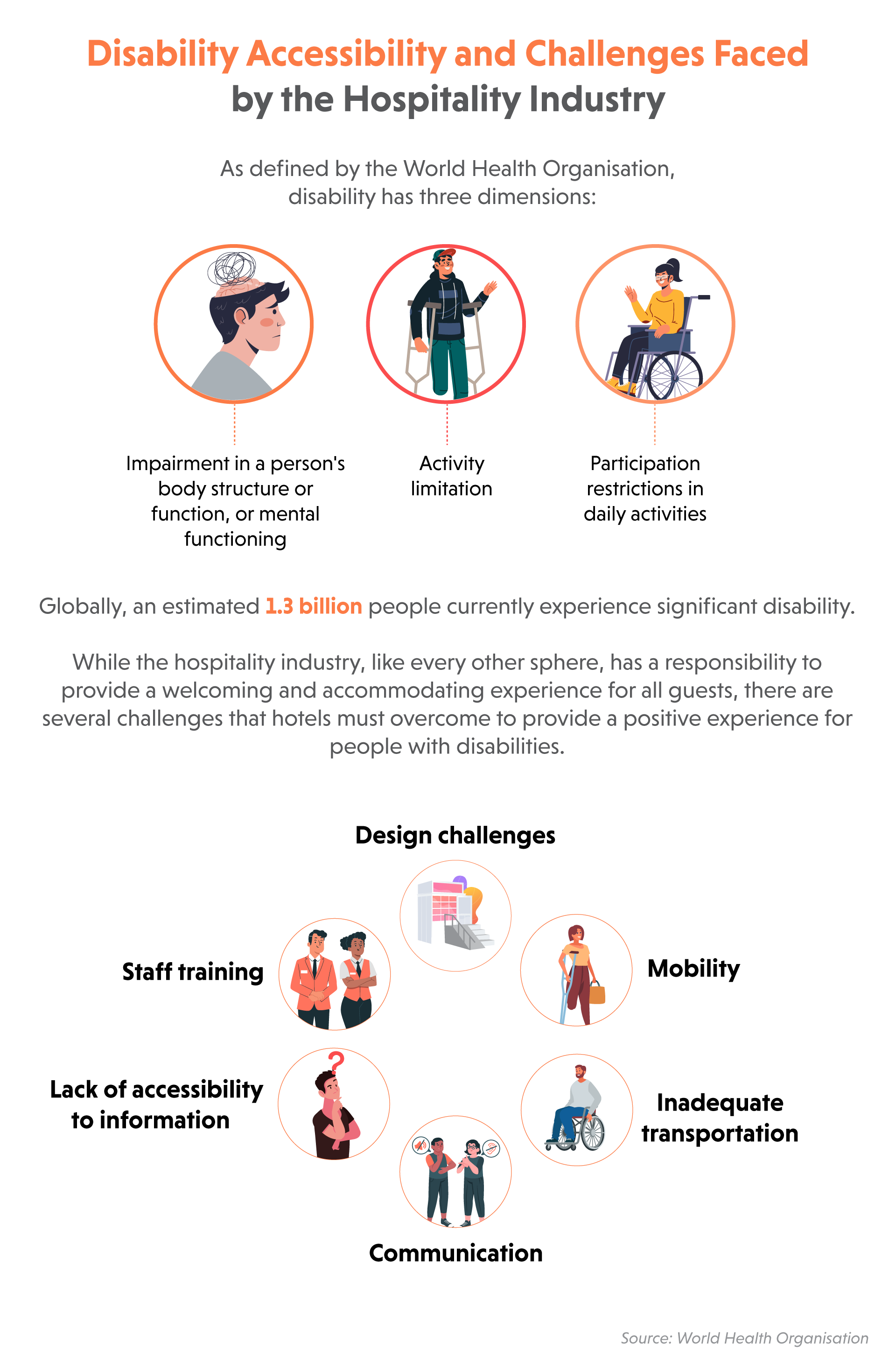By Tanya Girdhar John
Disability accessibility in hospitality is one of its most essential needs. According to an article by Skift more than half of hotels around the world don’t make it easy to book a room for senior citizens or guests with accessibility needs. While this may not be true for all hospitality businesses across the globe, the industry stakeholders have a responsibility to create spaces that cater to the diverse needs of their guests.
In today’s inclusive world, ensuring accessibility for all is not only a legal requirement but also a moral imperative. But the concept of accessibility also impacts businesses from a strategic standpoint. Businesses that close their doors to people with disabilities are not only appearing unappealing to socially and culturally conscious guests but are also losing potential revenue from this particular audience segment.
How to accommodate the different needs of guests?
Creating an inclusive environment is a multifaceted process and needs the restructuring of the architecture, tools and human resources involved. By focusing on the elements of architecture, technology and comprehensive employee training, hospitality establishments can take significant strides towards creating a truly inclusive environment.
These measures not only benefit guests with disabilities but also contribute to a more welcoming and enriching experience for all patrons.
Creating inclusive designs with accessible spaces
Inclusive designs refer to disrupting the traditional interior designs and the architecture of a space to make it more accommodating to people with different abilities. One prime example is the designs adopted by Hilton Hotels; Hilton properties provide roll-in showers and accessible tub/showers, lowered peepholes and grab bars at the toilet and shower to make bathroom spaces much easier to navigate for people with mobile impairments and using wheelchairs. Guest spaces can similarly be made more accessible with wider doorways, lower light switches, adjustable beds and proper turning radius for wheelchairs in restrooms.
More design elements that businesses can use are ramps, elevators and sloped entrances for wheelchair access, tactile paving or wayfinding systems for visually impaired guests. For instance, braille letters in elevator button panels help visually impaired guests to identify floor numbers without additional assistance. These solutions increase accessibility in personal as well as public hospitality spaces, making properties less discriminative.
Adopting technology as an accessibility bridge
Wyndham Hotels’ Hearing-Impaired Alarm System is the perfect example of hospitality establishments utilising technology to bridge accessibility gaps. Hospitality establishments have experimented with smart facilities such as voice-activated or touchpad-controlled systems to adjust lighting, temperature and other comforts. These facilities are not just a sign of luxury but a way of accommodating a wider range of accessibility challenges. To make sure customer special requests and needs are met, customer-facing ordering solutions, guest engagement apps and housekeeping modules are ideal—these are especially important to enhance staff responsivity speed and attend to guest needs.
Developing user-friendly apps that provide information on accessible facilities, real-time language translation and mobile-enabled check-in options also enhance the guest experience and caters to the different needs of each guest. Hospitality establishments also have the chance to understand guests’ needs, restrictions and preferences using their comprehensive ERP systems, thereby understanding dietary requirements, special room amenities such as headphones for auditory impairments and other data that help them customise their offerings and add a personalised touch to the service.
Employee training and awareness
Well-trained staff play a crucial role in ensuring a welcoming and inclusive environment. It is essential that hospitality employees are educated on various types of disabilities, including invisible disabilities (psychological and cognitive differences, for example), so they are aware of how to aid sensitively and effectively. Empathetic communication on the other hand helps hospitality spaces stronger with employees who connect with guests respectfully and compassionately, paying attention to individual needs, challenges and preferences. Ongoing training can also promote understanding and respect for guests from different cultural backgrounds and those with disabilities. Hospitality employees also need adequate training to assist guests with disabilities in an emergency, including evacuation procedures and the proper use of evacuation aids.
As properties adopt more and more technology to enhance their inclusivity and diversity awareness, it is also essential that employees are on top of these new tools and strategies. Robust training on operating smart systems, responding to requests lodged via guest service modules and managing other devices is essential in ensuring that service delivery happens smoothly. These training strategies make hospitality spaces more accepting of diversity, making guests of all backgrounds feel safe and welcome.
“Accessibility allows us to tap into everyone’s potential” ― Debra Ruh
Accessible hospitality refers to experiences that everyone can enjoy, no matter their degree of ability. This means spaces designed to accommodate individuals with reduced mobility or people with any kind of disability that create a holistic culture of acceptance and inclusivity in the industry.
It is also another element that makes the industry nail its sustainable goals, which goes beyond just protecting the environment but also bringing positive social, economic, and cultural impact. Embracing innovation, disrupting restrictive architecture, and investing in proper employee training allow hospitality businesses to thrive, entice more guests, and tap into unknown revenue potential.


